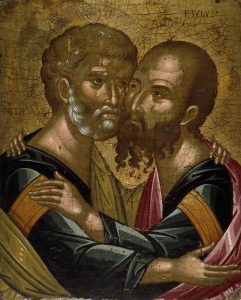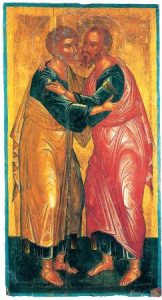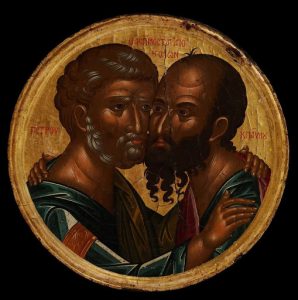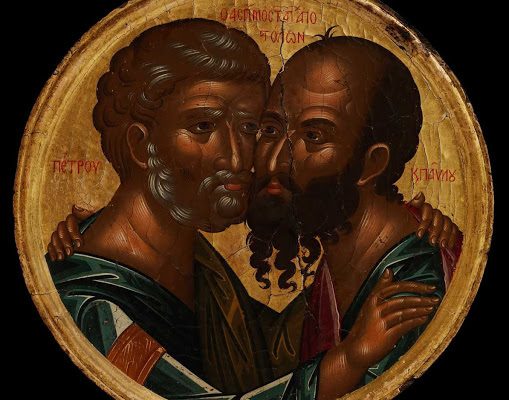Have you ever asked yourself why the feast days of St Peter and St Paul are celebrated on the same day, June 29th, and why, in the 15th century, so many icons of these two apostles were painted?

Icon of The Embrace of the Apostles Peter and Paul, 46.4 x 37 cm, Cretan school, Angelos Akotantos, 1st half 15th century (The Asholean Museum of Art and Archaelogy, Oxford, England)
In the Ashmolean Museum in Oxford, England hangs an icon called The Embrace of the Apostles Peter and Paul (Fig 1). The icon is 46.4 cm high and 37 cm wide and shows the apostles Peter and Paul in an embrace. They stand in bust on a background of gold, Peter on the left and Paul to the right. Their cheeks touch, but their eyes do not meet. The fingers of Peter’s left hand are visible on the shoulder of Paul and the fingers of the hand of Paul rest on Peter’s shoulder. Their other arms cross the front of their bodies in a gesture of embrace. The halos behind their heads have a perforated decoration with floral motifs of rosettes and tendrils. To the left of Peter is the Latin inscription (SANCTUS) PETR (US) and on the top right above Paul, S (ANCTUS) PAUL.
The Icon of the Embrace of the Apostles Peter and Paul was bequeathed to the museum in 1982. In the museum Bulletin Christmas 1982 and Easter 1983 there is a statement together with an illustration of the icon; “The museum is the beneficiary by the will of the late J.C. Thomson, former deputy headmaster of Charterhouse, and receives a number of articles of which the most important are three icons from the 16th century. The icon displayed here is Cretan and shows The Embrace of the Apostles Peter and Paul.” The text gives further details about the other two icons, both of which are Russian. How the Cretan icon came to be found in England is partly explained by a label that was afixed on the back of the image. It indicates that Thomson bought the icon in the first decades of the last century at an auction in England. Unfortunately it does illuminate further how the icon, from the Cretan workshop where it was created, made the long trip to an English auction house.

The Embrace of the Apostles Peter and Paul, Cretan school, Angelos Akotantos, 1st half 15th century (the Monastery of the Virgin Hodegetria, Crete)
According to specialists in Byzantine studies and iconography (Chatzidakis, Vassilaki, et al), the icon is attributed to the Cretan painter Angelos Akotantos who lived in the 15th century. He lived and worked in the capital Candia (now Heraklion) on the island of Crete. At that time the island was occupied by The Republic of Venice and Angelos was one of the skillful icon painters who carried on the high-level traditions of Byzantine art after the fall of Constantinople in 1453. The icon is part of a series of nearly identical paintings, two of which are signed by Angelos. First, there is a signed icon, ΧΕΙΡ ΑΓΓΕΛΟΥ, ‘By the hand of Angelos’, in the Monastery of the Virgin Hodegetria in Crete in which Peter and Paul are displayed in full length, embracing each other (Fig 2). There was a second signed icon by Angelos on the Greek island of Zakynthos, also illustrating an embracing Peter and Paul in full length, but it was unfortunately destroyed by an earthquake in 1953.

The Embrace of the Apostles Peter and Paul, tondo, diameter 37.5cm, Cretan school, Angelos Akotantos, 1st half 15th century (C. Krimbas Collection, Athens)
In addition, there are another four tondi or circular paintings with the image in bust of the Embrace of the Apostles Peter and Paul; in Athens (C. Krimbas collection, Fig 3), in the Monastery of Saint John the Theologian on Patmos, in Saint Catherine’s Monastery in Sinai and in the orthodox church in Topla in Bosnia and Herzegovina. On the basis of stylistic and iconographic similarities, these have been attributed to Angelos. The link with the painter is further supported by the fact that his last will and testament mentions an icon painted by him in Saint Catherine’s Monastery. The icon, also a tondo, would have been of Saint Catherine and having stylistic and iconographic affinities with the work of Angelos. Moreover, it had the same decoration with floral motifs in her halo as in the tondo of The Embrace of the Apostles Peter and Paul.
According to art historians, the theme of the Embrace of the Apostles Peter and Paul is rare in Byzantine art. That said, around 1450 it became a popular subject matter. It is quite probable that it had to do with the Council of Ferrara-Florence (1438-1439) and the efforts to bring about a reconciliation between the Western and Eastern churches. This hypothesis is strengthened by the fact that there is a Cretan icon hanging in the Galleria dell’Accademia in Florence, credited to Nikolaos Ritzos (documented in 1466, for 1507, Fig 4), which depicts Peter and Paul holding a model of a church. According to Professor Manolis Chatzidakis, the church is Santa Maria del Fiore in Florence where the Council was continued after Ferrara. However, it cannot be said with any certainty that Angelos’s icons of the Embrace of the Apostles Peter and Paul were painted to promote the union between Rome and Constantinople. But the fact that the icons were painted by him during the turbulent years of the Council of Ferrara-Florence must surely carry some meaning. One of the aforementioned specialists has no doubt that Angelos was a unionist. And we also know that for few years he held the important position of protopsaltes, having duties as, among others, first cantor, in the Christian church in Candia.
Author: Nelia Langeveld
